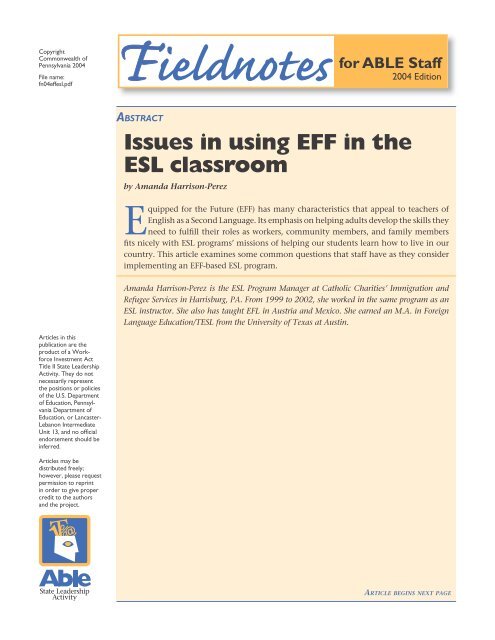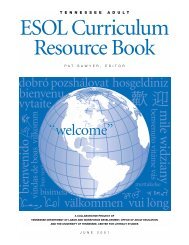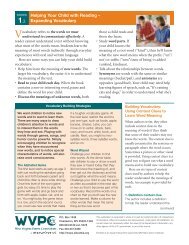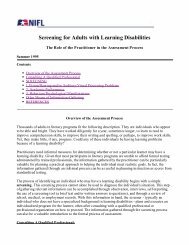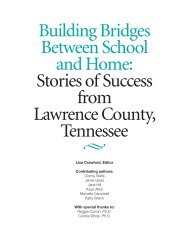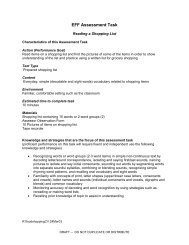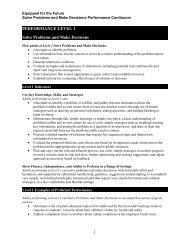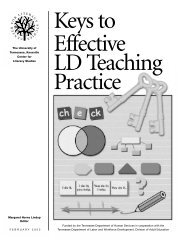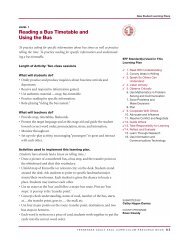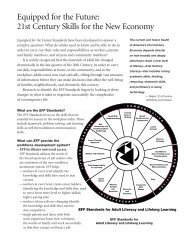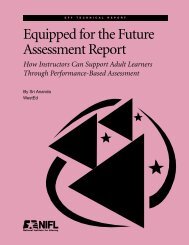Issues in using EFF in the ESL classroom - Equipped for the Future
Issues in using EFF in the ESL classroom - Equipped for the Future
Issues in using EFF in the ESL classroom - Equipped for the Future
Create successful ePaper yourself
Turn your PDF publications into a flip-book with our unique Google optimized e-Paper software.
3 <strong>Issues</strong> <strong>in</strong> us<strong>in</strong>g <strong>EFF</strong> <strong>in</strong> <strong>the</strong> <strong>ESL</strong> <strong>classroom</strong>2. Is it culturally <strong>in</strong>sensitive to teach adult English language learners our wayof do<strong>in</strong>g th<strong>in</strong>gs?This question is often a follow-up to <strong>the</strong> first po<strong>in</strong>t. The answer is that it depends on how<strong>the</strong> material is presented. If <strong>the</strong> teacher says or implies that <strong>the</strong> students’ cultural norms arewrong or bad and that “our way of do<strong>in</strong>g th<strong>in</strong>gs” is right and good, that is clearly culturally<strong>in</strong>sensitive. If, however, <strong>the</strong> <strong>in</strong><strong>for</strong>mation is presented as “this is how we do it here,” it can be<strong>in</strong><strong>for</strong>mative without be<strong>in</strong>g arrogant. <strong>ESL</strong> students are often pa<strong>in</strong>fully aware of cultural differencesand are eager to learn how and why Americans do <strong>the</strong> th<strong>in</strong>gs we do. Invit<strong>in</strong>g students totalk about <strong>the</strong>ir cultural background and experiences is an important part of any <strong>ESL</strong> class andcan provide a good foundation <strong>for</strong> learn<strong>in</strong>g English and understand<strong>in</strong>g U.S. cultural norms. Inaddition, <strong>the</strong>se conversations help teachers learn about <strong>the</strong>ir students’ native cultures. Suchcross-cultural awareness is an important aspect of teach<strong>in</strong>g adult language learners.3. When I ask my students why <strong>the</strong>y come to class, <strong>the</strong>y just say “to learn English.”How can <strong>EFF</strong> help learners to express specific goals <strong>for</strong> learn<strong>in</strong>g English?First, <strong>the</strong> question “Why do you want to come to class?” is a general one. There<strong>for</strong>e, <strong>the</strong>general answer “to learn English” isn’t surpris<strong>in</strong>g. Second, some students might not havespecific language goals; <strong>the</strong>y come <strong>for</strong> <strong>the</strong> social aspect or simply to learn. However, <strong>the</strong> majorityof <strong>ESL</strong> students do have specific goals; <strong>the</strong>y simply might not have thought <strong>the</strong>m outor might be unable to articulate <strong>the</strong>m on <strong>the</strong>ir own. Our role as <strong>in</strong>structors is to help <strong>the</strong>mdo so. Ask specific questions: Who do you need to speak English to? Where do you need touse English? What do you want to be able to do <strong>in</strong> English? If you ask specific questions, <strong>the</strong>ycan often give specific answers.4. How am I supposed to do goal-sett<strong>in</strong>g with my beg<strong>in</strong>n<strong>in</strong>g-level students if Idon’t speak <strong>the</strong>ir language? Can <strong>EFF</strong> help with this?The simplest solution, of course, is to have an <strong>in</strong>terpreter. However, <strong>in</strong> many circumstancesthis is not possible. Fur<strong>the</strong>rmore, our program has found that <strong>in</strong>terpreters sometimes <strong>in</strong>sert<strong>the</strong>ir own ideas and op<strong>in</strong>ions <strong>in</strong>to <strong>the</strong> translation. There<strong>for</strong>e, <strong>the</strong> <strong>in</strong><strong>for</strong>mation you receivemight not be exactly what <strong>the</strong> student expressed.If <strong>the</strong> students can understand some basic English, you can expla<strong>in</strong> <strong>the</strong> goal-sett<strong>in</strong>g <strong>in</strong>simple English. Write some simple, specific questions on <strong>the</strong> board. Then, allow <strong>the</strong> studentsto work <strong>in</strong> <strong>the</strong>ir native language. If <strong>the</strong>re are two or more students with <strong>the</strong> same native language,<strong>the</strong>y can work toge<strong>the</strong>r. Allow<strong>in</strong>g students to use <strong>the</strong>ir native language to completean activity <strong>in</strong> an <strong>ESL</strong> class might seem counter<strong>in</strong>tuitive. However, <strong>the</strong> purpose of goal-sett<strong>in</strong>gis to f<strong>in</strong>d out what our students want to learn, not to practice English. There<strong>for</strong>e, <strong>the</strong> use of<strong>the</strong> native language is legitimate. Once <strong>the</strong> students have been able to generate ideas <strong>in</strong> <strong>the</strong>irnative languages, <strong>the</strong>re are several options <strong>for</strong> gett<strong>in</strong>g <strong>the</strong>m <strong>in</strong>to English <strong>for</strong> you, <strong>the</strong> teacher,to understand. First, many students have bil<strong>in</strong>gual dictionaries and can look up key wordsto report to you. Second, <strong>in</strong> a class sett<strong>in</strong>g, students often help each o<strong>the</strong>r with vocabulary.Thus, if one student is hav<strong>in</strong>g difficulty express<strong>in</strong>g an idea, o<strong>the</strong>r students can often helpthat student f<strong>in</strong>d <strong>the</strong> correct words. Third, keep ask<strong>in</strong>g those simple, specific questions: Who?What? When? Where?Goal sett<strong>in</strong>g with students who have few or no English skills is more difficult, but not impossible.Use pictures. Create manipulatives us<strong>in</strong>g pictures from <strong>the</strong> <strong>EFF</strong> role maps, magaz<strong>in</strong>es,<strong>ESL</strong> textbooks, picture dictionaries, or computer clip art. Show <strong>the</strong> pictures to <strong>the</strong> students andCONTINUED
observe which ones generate responses. While this technique might not allow you to determ<strong>in</strong>ea student’s precise goals, you can discover <strong>the</strong> areas of importance to that student.5. What about grammar? Is <strong>the</strong>re room <strong>for</strong> it <strong>in</strong> an <strong>EFF</strong>-based program?The field of <strong>ESL</strong> has been mov<strong>in</strong>g away from a grammar-based approach to <strong>in</strong>struction.This does not mean that grammar <strong>in</strong>struction is unimportant, nor is it <strong>in</strong>compatible with<strong>EFF</strong>. Above all, <strong>EFF</strong> is about structur<strong>in</strong>g learn<strong>in</strong>g that is mean<strong>in</strong>gful and relevant to adults <strong>in</strong><strong>the</strong>ir everyday lives. Adults need to learn <strong>the</strong> grammar required <strong>in</strong> <strong>the</strong>ir daily <strong>in</strong>teractions.Research has shown that it is important to teach that grammar <strong>in</strong> a mean<strong>in</strong>gful context. It isalso important to make sure <strong>the</strong> students understand <strong>the</strong> connection between <strong>the</strong> grammarand <strong>the</strong> context. Take time to discuss with <strong>the</strong> students why <strong>the</strong> grammar po<strong>in</strong>t be<strong>in</strong>g coveredis so important <strong>in</strong> that context. For example, <strong>the</strong> simple past is often taught <strong>in</strong> <strong>the</strong> context oftalk<strong>in</strong>g about one’s work experience. Learners can understand <strong>the</strong> importance of differentiat<strong>in</strong>gbetween <strong>the</strong> work <strong>the</strong>y did <strong>in</strong> <strong>the</strong> past and <strong>the</strong> work <strong>the</strong>y are do<strong>in</strong>g at <strong>the</strong> present time.The past tense also is essential to <strong>the</strong>ir ability to talk about <strong>the</strong>ir life experiences.6. My <strong>ESL</strong> program uses textbooks. How can I <strong>in</strong>corporate <strong>EFF</strong> <strong>in</strong>to a class thatfollows a textbook?Once aga<strong>in</strong>, <strong>the</strong> key is to make <strong>the</strong> <strong>in</strong><strong>for</strong>mation relevant to <strong>the</strong> students’ lives. Teachersrout<strong>in</strong>ely adapt and supplement textbooks based on what <strong>the</strong>y believe <strong>the</strong>ir students need. It isjust one more step to f<strong>in</strong>d out, as is recommended <strong>in</strong> an <strong>EFF</strong> approach to <strong>in</strong>struction, what <strong>the</strong>students <strong>the</strong>mselves th<strong>in</strong>k <strong>the</strong>y need. One teacher <strong>in</strong> our program has found that conduct<strong>in</strong>ggoal-sett<strong>in</strong>g sessions centered on <strong>the</strong> topic of <strong>the</strong> unit about halfway through <strong>the</strong> unit is veryeffective, especially at <strong>the</strong> beg<strong>in</strong>n<strong>in</strong>g level. She teaches <strong>the</strong> first few lessons with<strong>in</strong> <strong>the</strong> unit.Then, once <strong>the</strong> students have been <strong>in</strong>troduced to <strong>the</strong> topic and some basic related vocabulary,she asks <strong>the</strong>m what else <strong>the</strong>y would like to learn related to that topic. This teacher’s approachillustrates that goal sett<strong>in</strong>g is an ongo<strong>in</strong>g process, ra<strong>the</strong>r than a once-and-done activity. Sometimes,<strong>the</strong> students’ requests are <strong>in</strong>cluded <strong>in</strong> <strong>the</strong> textbook; sometimes <strong>the</strong>ir requests are itemsrarely <strong>in</strong>cluded <strong>in</strong> textbooks. For example, <strong>in</strong> a goal-sett<strong>in</strong>g session <strong>in</strong> a unit on health andvisit<strong>in</strong>g <strong>the</strong> doctor, <strong>the</strong> teacher <strong>in</strong> our program learned that her students weren’t particularlyworried about talk<strong>in</strong>g to <strong>the</strong> receptionist to make an appo<strong>in</strong>tment or to <strong>the</strong> doctor to expla<strong>in</strong><strong>the</strong>ir medical problems, both of which were <strong>in</strong>cluded <strong>in</strong> textbook exercises. Nor did <strong>the</strong>y wantto practice read<strong>in</strong>g medic<strong>in</strong>e labels. Their ma<strong>in</strong> concern was understand<strong>in</strong>g and correctlynavigat<strong>in</strong>g <strong>the</strong> automated answer<strong>in</strong>g systems <strong>in</strong> use <strong>in</strong> most doctors’ offices. These systemsare a very real part of American life, and yet <strong>the</strong>y are rarely <strong>in</strong>cluded <strong>in</strong> textbooks.When an <strong>ESL</strong> program beg<strong>in</strong>s us<strong>in</strong>g <strong>EFF</strong>, it is important <strong>for</strong> all staff <strong>in</strong>volved to rememberthat it is a process. Many <strong>ESL</strong> students are accustomed to class content guided by a curriculumor a textbook with supplemental activities created by <strong>the</strong> teacher. They are not used to be<strong>in</strong>gasked what <strong>the</strong>y want to do, nor are <strong>the</strong>y used to participat<strong>in</strong>g <strong>in</strong> <strong>the</strong> development of classactivities. Initial attempts to set class goals or to <strong>in</strong>volve students <strong>in</strong> <strong>the</strong> plann<strong>in</strong>g process mightcreate some confusion, uncerta<strong>in</strong>ty, and resistance <strong>in</strong> <strong>the</strong> students. Instructors will likely haveto guide <strong>the</strong>ir students through <strong>the</strong> process step-by-step several times. They might also needto offer suggestions at each step along <strong>the</strong> way. The key is to be persistent. Our <strong>in</strong>structorshave found that, as learners repeat <strong>the</strong> process, <strong>the</strong>y become <strong>in</strong>creas<strong>in</strong>gly <strong>in</strong>volved and areeager to offer <strong>the</strong>ir ideas.4 <strong>Issues</strong> <strong>in</strong> us<strong>in</strong>g <strong>EFF</strong> <strong>in</strong> <strong>the</strong> <strong>ESL</strong> <strong>classroom</strong>


